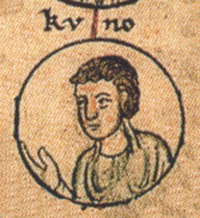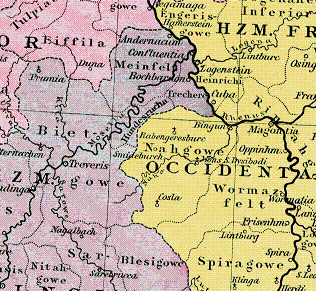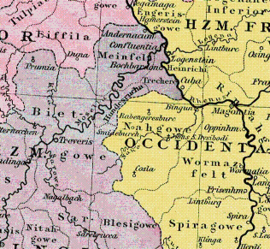The Salian dynasty was a dynasty in the High Middle Ages. The dynasty provided four German Kings (1024–1125), all of whom went on to be crowned Holy Roman Emperor (1027–1125); as such, the term Salic dynasty is also used to refer to the Holy Roman Empire of the time as a separate term.

The County Palatine of the Rhine, later the Electorate of the Palatinate or simply Electoral Palatinate, was a territory in the Holy Roman Empire administered by the Count Palatine of the Rhine. Its rulers served as prince-electors (Kurfürsten) from "time immemorial", were noted as such in a papal letter of 1261, and were confirmed as electors by the Golden Bull of 1356.

Conrad II, also known as Conrad the Elder and Conrad the Salic, was Emperor of the Holy Roman Empire from 1027 until his death in 1039. The founder of the Salian dynasty of emperors, Conrad also served as King of Germany from 1024, King of Italy from 1026, and King of Burgundy from 1033.

The Duchy of Carinthia was a duchy located in southern Austria and parts of northern Slovenia. It was separated from the Duchy of Bavaria in 976, and was the first newly created Imperial State after the original German stem duchies.
Frederick I was Duke of Swabia from 1079 to his death, the first ruler from the House of Hohenstaufen (Staufer).

Frederick II, called the One-Eyed, was Duke of Swabia from 1105 until his death, the second from the Hohenstaufen dynasty. His younger brother Conrad was elected King of the Romans in 1138.
Conrad, called the Red, was Duke of Lorraine from 944 until 953. He became the progenitor of the Imperial Salian dynasty.

Henry of Speyer, a member of the Salian dynasty, was count in the Rhenish Franconian Wormsgau. He was the father of Emperor Conrad II.

Otto I, called Otto of Worms, a member of the Salian dynasty, was Duke of Carinthia from 978 to 985 and again from 1002 until his death.
Adalbero of Eppenstein was Duke of Carinthia and Margrave of Verona from 1011 or 1012 until 1035.

Conrad I, a member of the Salian dynasty, was Duke of Carinthia from 1004 until his death.
Conrad II, called the Younger, a member of the Salian dynasty, was Duke of Carinthia and Margrave of Verona from 1035 until his death.

The Duchy of Franconia was one of the five stem duchies of East Francia and the medieval Kingdom of Germany emerging in the early 10th century. The word Franconia, first used in a Latin charter of 1053, was applied like the words Francia, France, and Franken, to a portion of the land occupied by the Franks.

Rhenish Franconia or Western Franconia (Westfranken) denotes the western half of the central German stem duchy of Franconia in the 10th and 11th century, with its residence at the city of Worms. The territory located on the banks of Rhine river roughly corresponded with the present-day state of Hesse and the adjacent Palatinate region in the south.
The Conradines or Conradiner were a dynasty of Franconian counts and dukes in the 8th to 11th Century, named after Duke Conrad the Elder and his son King Conrad I of Germany.
Werner V was a Rhenish Franconian count in the Nahegau, Speyergau and Wormsgau. He is one of the earliest documented ancestors of the Salian dynasty that provided German kings and Holy Roman Emperors from 1024 to 1125.
The Emichones were an early medieval family in the southwestern German region. Its members were counts (Gaugrafen) in the Nahegau, perhaps as undercounts of the Salian dynasty. The conventional name Emichones is due to the prevailing first name "Emich". Several later families may trace their origins to the Emichones.

The Nahegau was in the Middle Ages a county, which covered the environs of the Nahe and large parts of present-day Rhenish Hesse, after a successful expansion of the narrow territory, which did not reach the Rhine, to the disadvantage of the Wormsgau. Among other expansions were Ingelheim in 937, Spiesheim in 960, Saulheim in 973 and Flonheim in 996, until after the end of the expansion the Selz set the southern limit and the limit to the Wormsgau.

The Wormsgau was a medieval county in the East Frankish (German) stem duchy of Franconia, comprising the surroundings of the city of Worms and further territories on the left bank of the Upper Rhine river. Together with the neighbouring Nahegau and Speyergau, it belonged to the central Rhenish Franconian possessions of the Imperial Salian dynasty.

Stauf Castle is a ruined spur castle near the village of Stauf in the borough of Eisenberg in the county of Donnersbergkreis in the German state of Rhineland-Palatinate.














